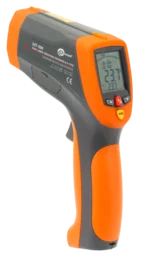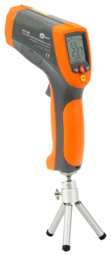Description
Easy way to quick and accurate temperature measurements
Professional and compact infrared (IR) thermometers are a solution
for problems in every area where specific thermal conditions are
required.
The intuitive one-hand operation of the devices and the
ergonomically designed gun-type housing allow for trouble-free daily
work.
Product features
- precise non-contact temperature
measurement
- type K temperature measurement
- ergonomic gun-type housing
- resolution 0.1°F (0.1°C)
- emissivity digitally adjustable from 0.10 to
1.00
- °C/°F switch
- automatic range selection
- high and low alarm
- DATA HOLD function for holding measured
values
- temperature display maximum, minimum, average
and difference
- trigger lock
- AUTO-OFF function
- backlit LCD
Special features
- Rapid reaction to temperature changes (below
150 ms).
- Double laser sight (determination of the
measurement area).
- Data memory (LOG) for 100
measurements.
- Transmission of current readings to computer
via USB cable.
- Backlit display for easy readings even in
dark areas.
- Hi and Lo alarms for signalling exceeding the
set limits of the measuring range.
Infrared measurements
Infrared temperature meters are used to determine the surface
temperature of the tested object. The optical system of the
instrument detects the radiation that is emitted, reflected and
transmitted, then gathers them and focuses it in the detector.
The electronic system converts the optical data into a temperature
value. To increase the precision of measurement and facilitate
targeting, the device is equipped with a laser pointer.
Infrared radiation
Infrared radiation is generated by the movement of electrons inside
the atoms of a given material. It is electromagnetic
radiation with a wavelength in the range of 780 nm…1 mm. It is
emitted by any material with temperature above 0°K (-273.15°C).
The emission increases with increasing temperature, whereas the
wavelength decreases.
Emissivity factor
It is a parameter that determines the ability of a material to emit
infrared radiation. Its values are in the range 0…1.
- A value equal to 1 is the emissivity of a
black body that absorbs all radiation.
- A value equal to 0 is the emissivity of a
white body (reflecting 100% of radiation).
Each object has its own emissivity factor, depending on the type of
material, surface roughness, viewing angle, wavelength and
temperature.
The D:S ratio
The D:S ratio (distance to spot) determines the relationship between
the distance of the pyrometer from the tested object and the
diameter
of its circular field of view, from where it collects the radiation.
The tested area becomes larger as the meter moves away from it, i.e.
the share of the tested object’s area in this field decreases.
Hence, the smaller is the measured target, the smaller should be the
distance
to it. Therefore, the D:S ratio has a significant influence on the
accuracy and precision of the temperature reading.



